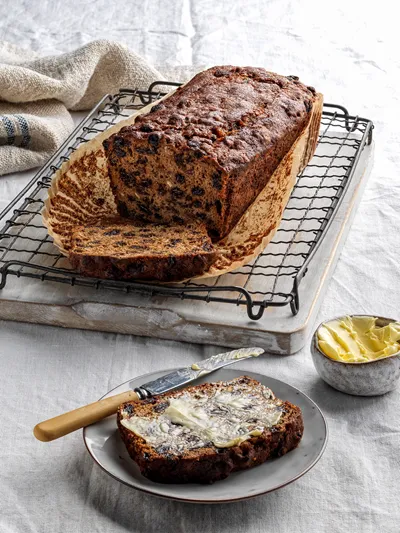Get a taste of Wales with these 12 traditional must-try dishes
The people of Wales traditionally worked in the mines or fields, and had long, exhausting days. Consequently, most Welsh food is hearty, resourceful, filling, and delicious.
“One cannot sleep well, love well, think well, if one has not dined well.” – Virgina Woolf
Food is more than just sustenance; it’s an expression of culture and traditions, a language that speaks to all our senses. The many stories and practices behind each dish, the rich tapestry of flavours and cultures, and the harmony of tastes and heritage create a unique lens to view the social and cultural history of a place and its people.
On a recent trip to Wales, I decided to do as the Welsh did. On a food-focused odyssey in Cardiff, I ended up exploring market stalls, discovering artisan producers, and meandering through the many streets, arcades, and markets.

Passionate about Welsh food, Sian Roberts offers tours, cookery workshops, and demonstrations.
Sian Roberts, the Founder of Loving Welsh Food, the first and only company offering food tours in Cardiff and the Vale of Glamorgan, welcomed us by handing over a paper bag containing a warm sweet treat: Welsh cakes.
Over the next couple of hours, I learnt a few bits and bobs of the Welsh language, culture, and cuisine. The food and culture walking tour revealed that the “land of dragons”, known for its rugged coastline, mountainous national parks, Celtic culture, and distinctive Welsh language, has a proud culinary heritage.
With great numbers of the workforce in Wales historically spending long, exhausting days, working in the mines or the fields, the food had to be hearty, resourceful, filling, and delicious.
“The signature dishes of this small but mighty country span the gamut–from hearty, meaty stews and fresh seafood to a sausage that’s vegetarian and unusual sweet treats. A couple of Welsh delicacies, including Glamorgan sausages and Caerphilly cheese, have become popular and can be found in eateries across the UK, but travelling to Wales is a must to try a few traditional dishes,” she says.
I sampled cheese, charcuterie, and cider tasting, cockles, laverbread, and faggots, meat pie, pizza, and local coffee, before ending with bara brith with a twist–a dollop of custard.

Loving Welsh Food offers food tours and tasting sessions through the arcades and markets of Cardiff.
It isn't just me. Wales is now being recognised around the world as a “food nation”. Last week, the Welsh government revealed that TasteWales 2023 saw “a record high for Welsh food and drink businesses as confirmed and potential sales reached £38 million”.
Packed with flavour and local ingredients, the traditional foods of Wales are a part of the country's history and heritage. The cuisine, like food worldwide, has a superpower: it brings people together.
So, here’s a roundup of the essential eats you must try when in Wales:

Also known as bakestones, Welsh cakes are a traditional sweet bread in Wales.
Welsh cakes: These baked goodies are made from flour, lard, sugar, dried currants, and warming spices like cinnamon and mace. Cooked on a griddle or heavy skillet, these flat roundels are slightly crisp on the outside and soft and moist on the inside. The dusting of powdered sugar when still warm is the final–and sweetest–finishing touch. “There’s nothing better than a warm Welsh cake with a cup of tea. The secret is to use all Welsh salted butter,” Roberts says.
Welsh rarebit: This dish that began life with the name “Welsh rabbit” in the 18th century was later renamed "rarebit", as the dish contains no rabbit. The dish seems to be the humble cheese on toast, but it’s much more. The traditional version comprises a savoury sauce that combines sharp cheddar cheese, stout/beer/ale, a dab of butter, Worcestershire sauce and English mustard spread onto toast and grilled. Roberts’ version includes “a strong Welsh cheddar, mustard, spring onions, Welsh beer and flour”.
Faggots: Long before the word was branded offensive, faggots were the poor man's meatballs! Derived from the idea of nose-to-tail eating, this inexpensive dish was a staple in the coal-mining villages of south Wales. Faggots are typically made of minced pork offal (heart, liver, or spleen), mixed with onions, spices such as sage or parsley, and breadcrumbs. The mixture is shaped into small balls, wrapped with fat or bacon, and baked in an earthenware dish. The hearty meatballs became popular during World War II and were used to supplement the small amounts of good meat each household received amid rationing. “This is a lovely dish for the winter. Faggots must be enjoyed with a thick gravy and mushy peas,” Roberts says.

Served with chunky bread, cawl is a wholesome one-pot meal.
Cawl: Dating back to the 14th century, cawl is to Wales what khichdi is to India. A hearty stew made from Welsh lamb, beef or bacon and root vegetables, this one-bowl meal is served with a slice of crusty bread, butter, and a wedge of cheese. Recipes differ from region to region, season to season, and family to family–but fresh and seasonal veggies are most likely to be tossed into the pot.
Laverbread: The sludgy, slimy Laverbread has little to do with bread. Made from laver, an edible seaweed collected off the coast of Wales, the dish is also called bara lawr, of “Welshman’s caviar”. The seaweed, boiled and made into a green paste, is the perfect accompaniment to a traditional Welsh breakfast of bacon and local cockles. The salty flavour can be a tad overpowering, but pairs well with bacon, eggs, and bread. Laverbread is also combined with rolled oats and fried in bacon fat to make breakfast favourite Welsh Laver cakes. “Some countries dry the seaweed; we boil it into a thick paste. It’s a very versatile ingredient for cooking and very good for you–low in calories, rich in protein, contains iodine and vitamins A, B2, C and D,” Roberts says.
Caerphilly cheese: The moist curd-like, crumbly white cheese was originally made in farms around the town of Caerphilly. It is thought to have been created to provide food for the local coal miners, a job it did well as it provided the salt content they needed and did not dry when taken underground. The production of Caerphilly cheese, which has a mild taste, with a hint of lemon, was stopped during World War II and then diverted to England. Majority of Caerphilly cheese is now produced in Somerset and Wiltshire, but the traditional stuff can only be bought from artisanal cheesemakers in Wales. Saying that this is one of Wales’ most famous cheeses, Roberts discloses that she uses it in “a favourite recipe of mine, fruit cake with Caerphilly cheese”.

Glamorgan sausages are vegetarian, made with Caerphilly cheese, leeks, and breadcrumbs. Photos: Visit Wales
Glamorgan sausages: Who would have cooked up a vegetarian sausage? Named after the historic county of Glamorgan, this traditional Welsh vegetarian sausage became popular during World War II when meat was tough to come by. Made with Caerphilly cheese (a descendant of the traditional Glamorgan cheese) and leeks, and coated in breadcrumbs, the recipe uses egg to bind the ingredients together. Modern variations include swapping the leeks with onions, adding varied herbs and spices, and using different kinds of cheese.
Aberffraw biscuit: The history of the Aberffraw biscuit, locally called teisen berffro, dates to the 13th century and Anglesey. Local lore goes that a Welsh king was holding court in Aberffraw when his wife found a pretty scallop shell during a walk on the beach, and requested a cake in the same form. And, the buttery biscuit was born. Among the UK’s oldest biscuits, the Aberffraw biscuit is made using the simplest of ingredients–flour, sugar, and butter–and remains an iconic treat. “It’s our version of shortbread, made with delicious salted butter!” Roberts says.
Giant Oggies: Legend has it the Oggie was first served to the builders of St David’s Cathedral in the 12th century–600 years before the Cornish pasty made an appearance. Like the pasty, which became a hearty, easy-to-eat and filling meal for Cornwall’s tin miners, the Oggie–much larger than its Cornish cousin–was a lunch staple for the many men who worked Wales’ coal mines. “It’s similar to a Cornish pasty but better! We use lamb and leeks as opposed to beef, swede and potato. Encased in shortcrust pastry, the hot snack is a complete meal,” Roberts says.
Tatws pum munud: The four-ingredient traditional Welsh dish goes back generations, courtesy the budget recipe that gives more bang for every buck. Made with potatoes, onions, carrots, bacon, and stock, this stew is simmered until the potatoes become tender, and then seasoned. Many Welsh children down the ages have grown up on a bowl of this nutritious broth. Tatws pum munud (also called five-minute potatoes) is often eaten with crusty bread, baked beans, and Worcestershire sauce.

Slathered with butter, a slice of bara brith makes for the perfect accompaniment to a hot beverage.
Bara brith: A traditional Welsh tea bread, Bara Brith derived its name from the Welsh language–bara means bread and brith means speckled. In olden times, the bread was typically made in farmhouses as a sweet treat for special occasions. Today, raisins, sultanas, and dried currants are soaked in tea overnight, and are added to the dough with candied citrus peel and mixed spice. The sweet treat is similar to the Irish Barmbrack, German Stollen, and Italian Panettone. “This is a delicious Welsh cake, best enjoyed with a lot of Welsh butter,” Roberts says.
Teisen lap: This Welsh farmhouse classic–also known as wet or moist cake–was baked fairly regularly in coal-mining villages of south Wales. It was every miner’s favourite lunchtime accompaniment as the moist texture of the cake, which is what lap (rarely used these days in Welsh) refers to, prevented it from crumbling. Traditionally baked on a plate, this “one big Welsh cake” is made with basic pantry ingredients like flour, dried fruit, butter, eggs, and nutmeg, and tastes almost like a spiced pudding, Roberts says.
Edited by Megha Reddy







